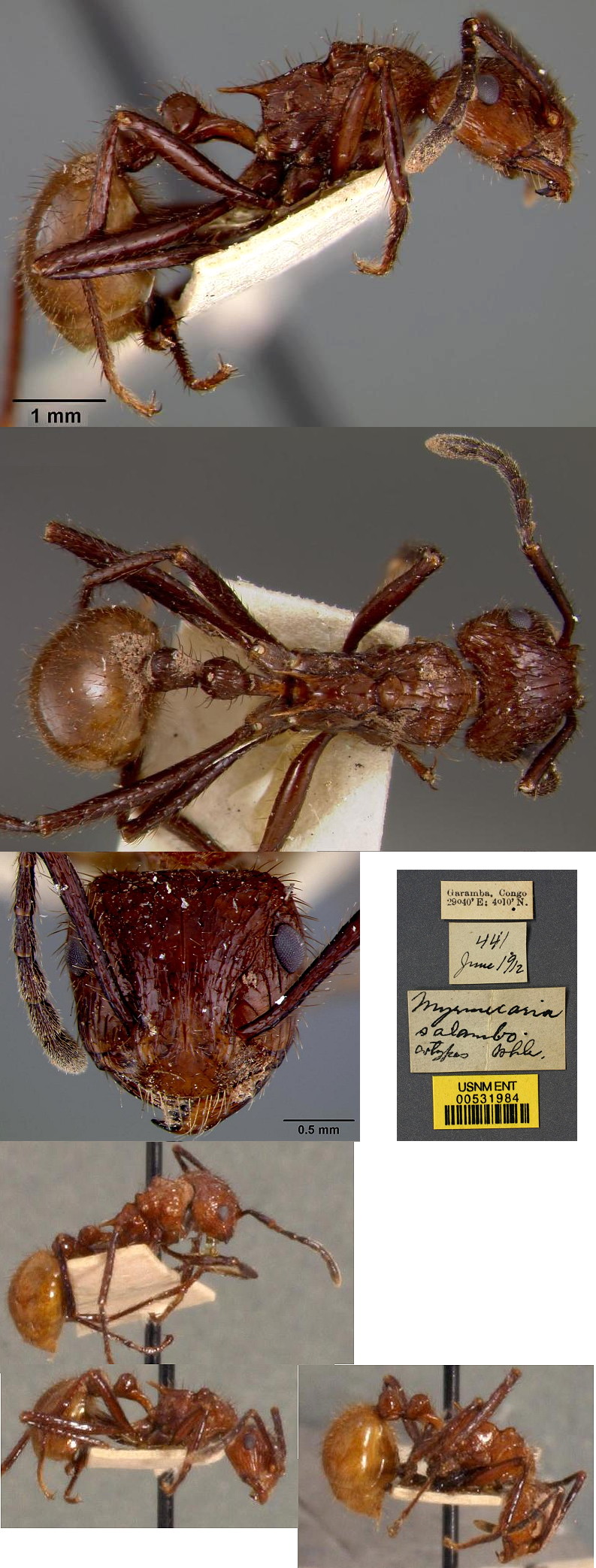 Wheeler's
description was: Wheeler's
description was:
WORKER - length 6 to 7 mm. Of rather uniform stature
and closely resembling eumenoides (M.
natalensis) but a little more elongate. Head relatively
smaller, as broad as long, excavated behind, convex above, flattened
below. Mandibles 5-toothed. Clypeus ecarinate, with entire anterior
border. Eyes somewhat larger and more convex than in eumenoides.
Thorax very similar but promesonotal suture very distinct, impressed,
the mesonotal lobes less compressed, their posterior outline in profile
less abrupt, more sloping so that the metanotal groove (mesoepinotal
impression), though deep, is shallower and less acute than in eumenoides
and appears longer. Propodeal spines longer, slightly sinuous, with
very feebly upturned points, directed backward and slightly outward.
Base of propodeum (epinotum) longitudinally concave. Peduncle of the
petiole longer than the node, which is thick and evenly rounded, not
compressed laterally above. The ventral surface of the petiole armed
below with two long, delicate hyaline spines, which curve towards each
other and enclose an elliptical space. Postpetiolar node of the same
size and shape as that of the petiole, its ventral surface straight in
profile, not bulging nor angulate in front. Gaster and legs of the
usual shape, the former with a straight, anterior border.
Shining; mandibles coarsely longitudinally striated; clypeus smooth in
the middle, with a few rugules on the sides. Rugosity of head, thorax,
and pedicel much as in eumenoides but the rugae on the dorsal
surface of the head and thorax less numerous and less pronounced,
without distinct anastomoses; sides of the head with finer and less
distinct rugulae, so that the surface is more shining. Gaster opaque
and very finely punctate only at the extreme base above, otherwise
shining. Legs and scapes shining, finely striate.
Hairs dark brown, in length and arrangement much like those of eumenoides.
Reddish brown; gaster brownish yellow; legs, including the coxae and
lower pleurae, darker than the thorax. Mandibular teeth and antennae
blackish.
This form is so closely related to eumenoides that it might,
perhaps, be regarded as a subspecies. It is easily recognized by the
unique ventral appendages of the petiole. These are so brittle that
they are easily broken off, but their basal insertions on the low
hyaline lamella in the midventral line of the petiole are usually
discernible. Evidently salambo is also related to M. striata
Stitz, specimens of which I have not seen.
|
 The
photomontage of cotypes is collated from The
Smithsonian Institute images at http://ripley.si.edu/ent/nmnhtypedb/public/specimeninfopage.cfm?publicconsumption=1&typespecimenID=1125. The
photomontage of cotypes is collated from The
Smithsonian Institute images at http://ripley.si.edu/ent/nmnhtypedb/public/specimeninfopage.cfm?publicconsumption=1&typespecimenID=1125.
BT Note: the specimens shown in the photomontage show no
signs of the subpetiolar appendages. The overall set of features,
however, does appear to be distinctive, e.g. the squarer head, thicker
funiculus segments and the pale gaster, compared with M.
natalensis. The workers from Senegal, shown, below,
however, do have the subpetiolar processes, as well as sharing the
other described features.
|